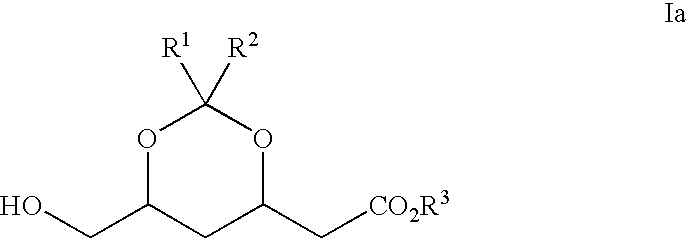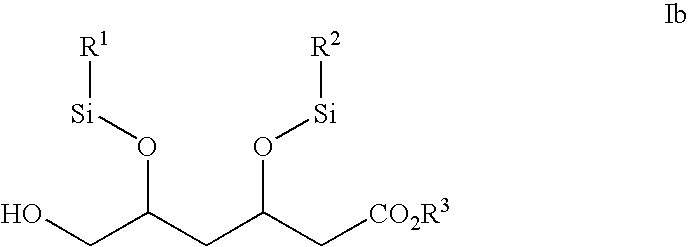Novel boronate esters
a boronate and ester technology, applied in the field of optically active boronate derivatives, can solve the problems of ruthenium stereoselective reduction, purification problems, and process not industrially scalabl
- Summary
- Abstract
- Description
- Claims
- Application Information
AI Technical Summary
Benefits of technology
Problems solved by technology
Method used
Image
Examples
example 1
[0186] Synthesis of methyl 4-triphenylmethyloxy-3(S)-hydroxybutyrate: To 25 g of methyl 3(S), 4-dihydroxybutanoate was added 250 mL of DCM and stirred to dissolve. 19.8 g of pyridine was added and cooled to 0° C. 41.4 g of trityl chloride was dissolved in 50 mL of DMC and was added at 0-5° C. for 15 minutes. The temperature was allowed to rise to room temperature and was stirred at room temperature for 17 hours. Water was added and the layers were separated. The organic layer was washed with brine, dried and concentrated. The residue was triturated with 25 mL of cyclohexane and the product was purified to give 15 g of the pure product. 1H NMR (CDCl3): 4.25 (m, 1H), 3.6 (s, 3H), 3.15 (d, 2H), 2.5 (m, 2H), 7.2-7.4 (m, 15H).
example 2
[0187] Synthesis of tert-butyl 6-triphenylmethyloxy-5(S)-hydroxy-3-oxohexanoate: 125 mL of THF and 24 g of diisopropylamine were charged and cooled to −15 ° C. 168 mL of 1.2 N n-BuLi was added at −15 to −5° C. and was stirred for 30 minutes. 21.56 g of tert-butyl acetate in 45 mL of THF, which was pre-cooled to −45° C., was added maintaining the temperature between −45 to −25° C. for 60 minutes. The reaction mixture was cooled to −45° C. and 30 g of methyl 4-triphenylmethyloxy-3(S)-hydroxybutyrate in THF was added over a period of 20 minutes and the stirring was continued at −25° C. for 90 minutes. Water was added and the layers were separated. The aqueous layer was extracted using EtOAc and the combined organic layers were washed with brine, water, dried and concentrated to give the title compound which was used as such for the next step.
example 3
[0188] Synthesis of tert-butyl 6-triphenylmethyloxy-3(R),5(S)-dihydroxyhexanoate: To the crude tert-butyl 6-triphenyhnethyloxy-5(S)-hydroxy-3-oxohexanoate was added 150 mL of THF followed by 15 mL of MeOH and was chilled to −60° C. 26 mL of methoxydiethylborane (50% solution in THF) was added over a period of 20 minutes and stirring was continued for a further 30 minutes. The reaction mixture was cooled to −80° C. and 5 g of sodium borohydride was added in portions and the after completion of addition the reaction mixture was stirred for 5 hours at −78° C. Acetic acid was added to adjust the pH to 7 and water was added. The aqueous layer was extracted using EtOAC, washed with brine, dried and concentrated to give the title compound which was used as such for the next step.
PUM
| Property | Measurement | Unit |
|---|---|---|
| temperature | aaaaa | aaaaa |
| temperature | aaaaa | aaaaa |
| temperature | aaaaa | aaaaa |
Abstract
Description
Claims
Application Information
 Login to View More
Login to View More - R&D
- Intellectual Property
- Life Sciences
- Materials
- Tech Scout
- Unparalleled Data Quality
- Higher Quality Content
- 60% Fewer Hallucinations
Browse by: Latest US Patents, China's latest patents, Technical Efficacy Thesaurus, Application Domain, Technology Topic, Popular Technical Reports.
© 2025 PatSnap. All rights reserved.Legal|Privacy policy|Modern Slavery Act Transparency Statement|Sitemap|About US| Contact US: help@patsnap.com



